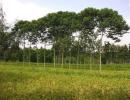
|
Umbrella-tree
Scientific name:
Maesopsis eminii
Order/Family:
Rhamnaceae
Local names:
Common names: Luhya (Mutere, Muhunya)
|
Introduction
It's a large timber tree typical of rainforest from West and central Africa and reaching its natural eastern limit in the Kakamega forest. It is widely planted in wetter highland districts of western Kenya and north eastern Tanzania. Also grown in Taita Hills as a timber tree.
 |
| Distribution of Maesopsis eminii in Kenya |
| © Maundu P. and Bo Tengnas. (2005). Useful trees and shrubs for Kenya, World Agroforestry Centre. |
General information about the tree:
Although the species can be intercropped, maize production is affected due to heavy shade as the trees grow bigger. Tree not resistant to fungi or termites and so rots quickly. Hornbills and chimpanzees eat the fruit and disperse the seed. It is internationally listed as an invader; so care with further spread is needed.
Biophysical Limits:
Altitude: 700-1500 m,
Mean annual temperature: 22-27 deg. C,
Mean annual rainfall: 1200-3000 mm
Soil type: M. eminii is tolerant a wide range of site conditions but grows best on deep, moist and fertile sandy loam soils with a neutral to acid pH.
Flourishes in agro-ecological zone I - II
Mean annual temperature: 22-27 deg. C,
Mean annual rainfall: 1200-3000 mm
Soil type: M. eminii is tolerant a wide range of site conditions but grows best on deep, moist and fertile sandy loam soils with a neutral to acid pH.
Flourishes in agro-ecological zone I - II
Propagation and Tree Management
Seedlings, wildings and direct sowing at site may be used. It is fast growing and coppices well while young. Occurs in plantations, mixed and enrichment systems
Products:
- Fodder: The leaves are used as fodder; digestibility of the leaves by livestock is excellent and only slightly reduced by heating.
- Fuel: Due to its fast growth, M. eminii is widely planted for firewood production.
- Fibre: it is sometimes cultivated for fibre production.
- Timber: The wood saws and machines easily, and its high absorbency makes it easy to treat with preservatives but difficult to finish. M. eminii wood is used in poles, boxes, crates, millwork, plywood, corestock and lumber construction.
- Lipids: Analyses of M. eminii seed from Karnataka, India, indicate that they contain 40-50% of an edible oil,
- Medicine: A strong purgative and diuretic can be made by soaking the bark in cold water. The root bark may be beaten with clay and used to treat gonorrhoea.
Services:
- Shade or shelter: M. eminii has been successfully used as a shade tree for coffee in Uganda, cocoa in the Democratic Republic of Congo, and cardamom plantations in southern India and in home gardens for shade.
- Ornamental: M. eminii is a common ornamental planted along roads.
- Reclamation: It is used for reforestation purposes, especially in Zaire.
Pests and Diseases
M. eminii's enemies include the cerambicid beetle Monohammus scabiosus, which excavates galleries into pole-sized stems, making the stem liable to snap off during high winds. Canker may form when the tree is attacked by a pathogenic complex of Fusarium solani and Volutella spp. Browsing animals can also do considerable damage to seedlings and saplings. In Uganda a canker, caused by Fusarium solani was described in young trees growing in poor soil.
Information Source Links
- Beentje HJ. (1994). Kenya trees, shrubs and lianas. National Museums of Kenya.
- Bekele-Tesemma A, Birnie A, Tengnas B. (1993). Useful trees and shrubs for Ethiopia. Regional Soil Conservation Unit (RSCU), Swedish International Development Authority (SIDA).
- Birnie A. (1997). What tree is that? A beginner's guide to 40 trees in Kenya. Jacaranda designs Ltd.

 Back
Back
